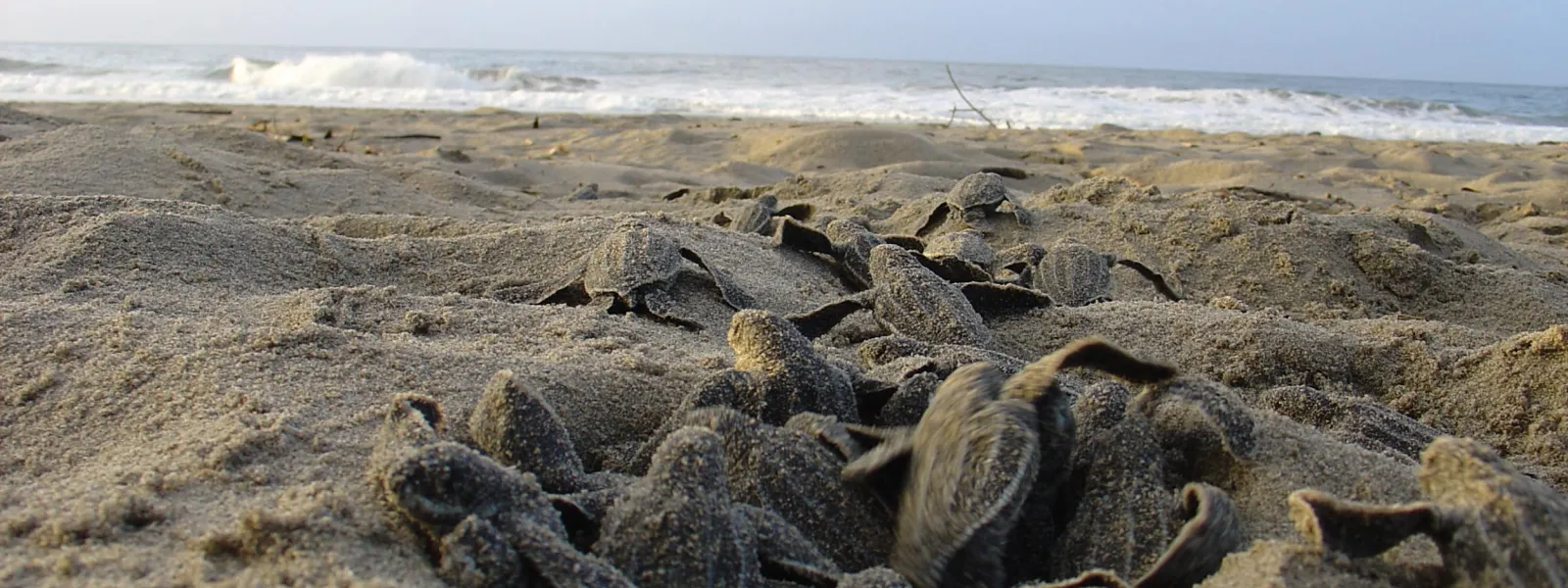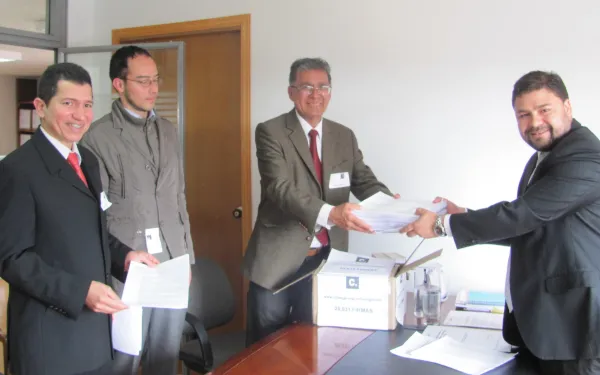
Project
Victory: Haven for leatherback sea turtles declared off-limits
In two separate rulings in May 2008, the Costa Rican government stood up for endangered leatherback sea turtles against business interests intent on building within their protected habitat.
A relative of dinosaurs, the endangered leatherback sea turtle has continually found its home in Costa Rica under threat. Poor planning and lack of oversight destroyed its nesting beaches in Flamingo and Tamarindo.
This time developers had their eye on the Leatherback National Marine Park (LNMP), home to some of the most important Leatherback nesting beaches in the Eastern Pacific Ocean.
A municipal zoning regulation was enacted that would authorize construction in part of the LNMP. However, AIDA and its local partner CEDARENA, together with the Leatherback Trust, successfully defended the park.
The Constitutional Chamber of the Costa Rican Supreme Court nullified the municipal zoning regulation, safeguarding the Leatherback sea turtles and their nesting beaches. This ruling closely followed another court victory by AIDA, CEDARENA, and Justice for Nature that required the government to expropriate the private lands within the LNMP, otherwise destined to be tourist playgrounds.
The leatherback sea turtle will continue to face threats from tourism development, fishing, egg poaching, and pollution. However, AIDA and its partners have shown that the law can be used to make a powerful difference.
Related projects
AIDA celebrates historic decision to suspend fumigation with glyphosate in Colombia
AIDA calls on the National Environmental Licensing Agency to immediately cancel the permit authorizing the chemical spraying program. Thanks to more than 24,000 people who signed a petition on Change.org to suspend fumigation and to colleagues and organizations that participated in the campaign. Bogota, Colombia. The Interamerican Association for Environmental Defense (AIDA) welcomes the Colombian government’s decision to suspend the aerial spraying of coca and poppy crops with glyphosate in the country. To implement this decision, the National Environmental Licensing Agency must rule immediately and cancel the permit granted to the chemical spraying program. "This is a historic moment for health, the environment, and respect for law in Colombia," said Astrid Puentes Riaño, Co-Director of AIDA. "We know it was a complex decision, but in light of a policy that has proved ineffective and caused serious damage, it was also a smart decision to change course and find real solutions." AIDA has followed the Illicit Crop Eradication Program in Colombia since the late 1990s. We have repeatedly decried the serious damage to health and the environment caused by the glyphosate mixture applied in Colombia, and advocated more appropriate alternatives to eradicate coca and poppy crops. The decision to suspend the spraying, made last night by the National Narcotics Council with an overwhelming majority of seven votes to one, will become effective if the National Environmental Licensing Agency revokes the permit authorizing the program. AIDA believes that the permit should be canceled immediately because the program was designed to use glyphosate, and without it the program no longer makes sense. One day before the decision, AIDA delivered a petition to suspend the spraying, with more than 24,000 signatures, to the Minister of Justice, who also chairs the Narcotics Council. The petition, posted on Change.org, was sponsored by AIDA in conjunction with the Institute for Studies of Development and Peace (INDEPAZ) and the Observatory of Crops and Growers Declared Illicit, with support from Washington Office on Latin America and Latin American Working Group. In one week the petition received 24,933 signatures. "We thank everyone who signed and those who for years have requested this change in policy; this is a shared achievement," said Hector Herrera, AIDA attorney and coordinator of the Environmental Justice Network in Colombia. "We look forward to creation of a technical committee to make recommendations and hope that it is participatory and transparent." The suspension of the fumigation program followed a finding, issued by the World Health Organization’s International Agency for Research on Cancer, that glyphosate may be carcinogenic. This finding led the Ministry of Health to recommended suspending the program, which Colombia’s Constitutional Court and other national courts had unsuccessfully requested years before, citing the precautionary principle. This principle, found in international environmental law, was incorporated into Colombian legislation in 1993. It holds that in the absence of scientific certainty, when a risk of serious or irreversible health or environmental damage may be present, the authorities should take steps to avoid that risk. In the case of spraying, the requirements for applying the precautionary principle are met. Although there is no absolute scientific certainty of causal harm, more than 15 years of evidence points to possible serious and irreversible damage to health and the environment, including risk of cancer and skin diseases, damage to amphibians and fish, and damage to forests and food crops. The Colombian government, for the sake of caution, finally suspended spraying to prevent further damage.
Read more
More than 20,000 petition Colombia to stop aerial spraying of herbicides
Less than 24 hours before the National Narcotics Council decides whether to suspend the spraying, organizations deliver a citizens’ petition seeking a halt to social and environmental damages. Bogota, Colombia. A coalition of nongovernmental organizations delivered a petition with more than 20,000 signatures to the Ministry of Justice today, urging a stop to widespread aerial spraying of glyphosate and other harmful chemicals over large swaths of land in Colombia with the objective of eradicating coca and poppy crops. The petition highlights the need to protect the environment and human health from damages caused by the spraying, which is done over forests, homes, farms and water sources. Organizations sponsoring the petition, which was posted on the website Change.org, include the Interamerican Association for Environmental Defense (AIDA), the Institute for Development and Peace Studies (INDEPAZ), the Observatory of Crops Declared Illicit, the Washington Office on Latin America, and Latin American Working Group. “In just a few days we received more than 20,000 signatures saying ‘no’ to the fumigation, not only with glyphosate, but with any herbicide used as an instrument in the war against drugs,” said Camilo González, Colombia’s former Minister of Health. The National Narcotics Council, chaired by the Ministry of Justice, will meet today to decide whether or not to suspend the spraying. “The Council should make its decision on the basis of law, considering scientific and technical evidence about the harmful impacts of spraying and the lack of desired results,” concluded Hector Herrera, attorney for AIDA and coordinator of the Environmental Justice Network of Colombia. Alongside sponsoring organizations, the signers of the petition emphasize that the spraying should come to an end because it: Causes serious health impacts: The World Health Organization’s International Agency for Research on Cancer determined that glyphosate may cause cancer in humans. Independent studies have also documented other serious health effects from the spraying, such as skin diseases and problems during pregnancy. Has not achieved its objective: Over more than 15 years, the spraying has failed to reduce the cultivation of coca and poppy crops for illicit use. Causes serious environmental impacts: Spraying has been done indiscriminately over homes, farms and water sources. As a consequence, it has damaged biodiverse ecosystems and the species that live in them (fish, amphibians, rodents, insects, and endemic plants), polluted water, destroyed forests, and damaged food crops, a source of subsistence for many communities. Displaces people: Having no alternatives to coca and poppy cultivation, entire families have left their land because of the spraying. Ignores national and international socio-environmental standards: National tribunals such as the Constitutional Court have requested the suspension of spraying based on the precautionary principle. Colombia compensated Ecuador for the damages the spraying has caused along the border, and promised to suspend the practice in that region. National and international experts explained these and other reasons to halt the aerial spraying program in a seminar today at the Center for Memory, Peace and Reconciliation in Bogota. “For 40 years, the spraying of pesticides has been the subject of academic, scientific and legal analysis, which, though recommending the end of their application, have not always been public. These analyses have been dominated by politics of security and public order, but have left out health, environmental and legal recommendations. This approach has denied the existence of the socio-economic problems that persist in communities where crops are grown; it has denied the importance of recognizing the human rights of rural communities; and it has not recognized the new approach recommended by the United Nations Development Program to contain the expansion of illicit crops,” explained Pedro Arenas, coordinator of the Observatory of Crops Declared Illicit, who moderated the discussion group. The Ministry of Health, the provincial and district secretaries of Health, the Ombudsman, and the Attorney General’s Office, among other authorities, agree with the thousands of people who signed the petition and the organizations that have promoted it. The petition is still open for signatures! Sign Here: chn.ge/1zPK74G!
Read moreIFC boosts investment in contested Canadian mining project in Colombia despite ongoing investigation
Washington, DC – On April 24, more than 50,000 Colombians took to the streets in Bucaramanga in a march to defend their primary water source from the development of Eco Oro Minerals’ Angostura gold project and other proposed mining activities. Despite broad public opposition and an ongoing investigation into an earlier investment decision, the private lending arm of the World Bank, the International Finance Corporation (IFC), bought more shares in Eco Oro Minerals in February. The IFC’s original decision in 2009 to invest in Eco Oro is the subject of an ongoing investigation by the World Bank’s Compliance Advisor Ombudsman about whether its social and environmental sustainability policies were violated. In February, without waiting for a decision on the ongoing investigation, the IFC purchased an additional 390,000 shares in Eco Oro Minerals for a total investment of US$18.4 million. Members of the Committee for the Defense of Water and the Santurbán Páramo brought the original complaint to the CAO in June 2012 and have decried the fact that mining is illegal within the páramo. "This mining project and the others that it stimulates in the area will put the drinking water of millions of us at risk. We have clearly stated that we want the IFC to divest, not reinvest," remarked Carlos Lozano Acosta, attorney at the Interamerican Association for Environmental Defense (AIDA). The Santurbán Páramo is a high altitude wetland ecosystem that provides water for approximately 2 million people in the region. "This new investment is irresponsible. The IFC needs to learn from the past; investments in mining have led to violent conflict and human rights violations throughout Latin America, stated Carla Garcia Zendejas, Program Director at the Center for International Environmental Law (CIEL). “Given that there is an open investigation, at a minimum the IFC should wait for their own compliance office to determine if their original investment in the mine violated their own policies before making any further decisions" Garcia Zendejas said. Violence has already taken place in the area of Eco Oro operations. The complaint presented to the CAO alleges that the IFC glossed over potential security issues related to the Angostura project. It includes documented evidence of violence associated with guerrilla and paramilitary activity following a major military operation and the establishment of military installations in the area around 2003. “The IFC is investing in conflict and lending legitimacy to an activity that downstream communities and organizations have clearly opposed out of concern for their future well-being. The IFC should start listening to the Colombian people and withdraw,” commented Jen Moore, Latin America Program Coordinator for MiningWatch Canada.
Read more